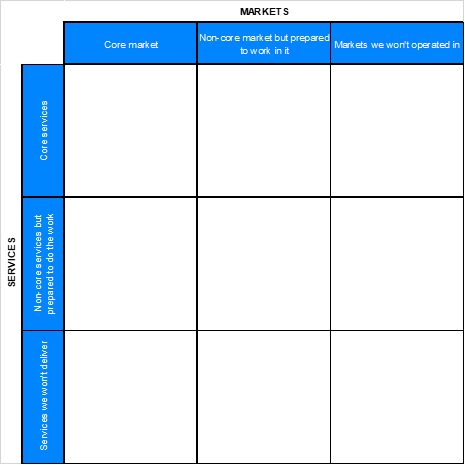
Unlock the full potential of your consultancy’s strategic plan
Have you ever got to the end of a quarter, or a year, to find that you haven’t achieved your strategic objectives because you and your leadership team have been too absorbed in the operational workings of your consultancy?
Are your strategic objectives taking longer to fulfil than you know they should, despite your long hours? Are you frustrated about that, and do you sense frustration in those around you too?
Have opportunities passed you by because you haven’t created the space to properly consider whether you should adapt your strategic objectives?
I expect you are nodding away to one, if not all, of these. And unfortunately, you’re not alone.
On average, partners of sub-£20m consultancies spend an excessive 47% of their time with clients, and only 10% of their time on their strategy.
Consultancy BenchPress 2020/21
The experiences of many consultancies show that it simply isn’t enough to develop your strategic plan. You have to work consistently hard at implementing it.
In this article I explain what will (and won’t) happen if you don’t stay true to delivering on your strategy, and some of the cultural, structural and operational processes you can put in place to get your business to where you want it to be.
Why you need to pay more attention to your strategy
Not giving your strategy the regular and in-depth attention it deserves has serious implications for your consulting business. . Here are three of them.
1. Atrito aumentado
Imagine a cena: é outra reunião da equipe de gerenciamento sênior e você está falando de estratégia - mas brevemente, porque há muitos outros assuntos urgentes na agenda. Todo mundo sabe que existem questões estratégicas nos negócios, e as soluções foram identificadas para algumas delas, mas não há o suficiente. Em parte porque você está muito envolvido no cumprimento dos requisitos diários de seus clientes para pensar e agir totalmente sobre os principais problemas do seu negócio. E também porque você está muito preso nas negras operacionais, por isso não teve tempo de investigar e resolver todos os problemas estratégicos que sustentam os problemas que se manifestam na superfície.
Você pode prever o resultado. Sua equipe não pode tomar as decisões certas para enfrentar as questões mais importantes dos negócios. E você não pode capitalizar completamente as oportunidades que surgem agora e no futuro. Além disso, como o proprietário que você acaba trabalhando ainda mais horas, provavelmente, não faz as coisas que você é melhor.
Essa falta de atenção em nível estratégico rapidamente leva à desilusão em sua equipe sênior. Eles perdem a fé na estratégia e, se você não é cuidadoso, também em sua liderança.
Um aumento na taxa de atrito da sua equipe é o local óbvio para identificar sinais de frustração e desengajamento.
2. Ineficiência e inconsistência do processo interno
Todos nós sabemos que, em um mundo ideal, uma vez que um projeto termine, um modelo de prática recomendada e um conjunto de diretrizes é desenvolvido para garantir a qualidade, a consistência e o valor para o dinheiro na próxima vez que você fizer algo semelhante. É o fio de ouro que percorre todo o seu trabalho para impedir que as pessoas reinventem a roda e para garantir que seus clientes obtenham a melhor experiência possível.
O mesmo vale para muitos outros aspectos de suas operações, incluindo arremesso, recrutamento, recursos, marketing e…. Implementação estratégica. Dom Moorhouse, que vendeu sua consultoria por 20 milhões de libras após apenas 5 anos e agora é especialista em crescimento para a Rede de Crescimento da Consultoria, diz em seu livro o guia de cinco anos de empreendedor:
A lack of investment in continually thinking about your strategy, and in continually improving it, means there is no best practice example for staff to work towards. As Dom Moorhouse, who sold his consultancy for £20m after just 5 years and is now a Growth Expert for The Consultancy Growth Network, says in his book The Five Year Entrepreneur Guide:
“The point of your strategic plan is not to give you an immutable roadmap, but rather an intelligent sense of direction around which you can assess, review and pivot in the future.”
Dom Moorhouse
Como uma equipe, você só pode tomar as decisões certas e capitalizar totalmente as oportunidades se tiver os processos para ativá -las. Se você souber quais recursos você precisará nos negócios se quiser cumprir suas ambições em 2 a 3 anos, quanto mais cedo você aumentar a conscientização de sua equipe, maior a probabilidade de encontrar pessoas nesse meio tempo e/ou sua equipe desenvolverá as capacidades necessárias internamente.
A great example of this is building out your future organisational structure. If you know what capabilities you will need in the business if you are to fulfil your ambitions in 2-3 years’ time, then the sooner you raise your team’s awareness the more likely you will find people in the interim, and/or your team will develop the necessary capabilities internally.
3. Reduzindo a opção quando se trata de sair
Se, como muitos proprietários de empresas de consultoria, você espera sair do seu negócio um dia e navegar para o pôr do sol, tendo realizado um ganho de capital considerável, então seu nível de foco estratégico é fundamental. Os empresários são oportunistas por natureza, mas essa força pode ser uma fraqueza quando se trata de construir algo que alguém queira comprar. O grande risco associado à adoção de uma abordagem oportunista do crescimento é que você pode restringir involuntariamente o universo do seu comprador. Assim que você complicar a amplitude da oferta, o número de mercados em que você opera, o número de recursos necessários para desenvolver, quanto menos compradores estarão prontos para pagar um múltiplo premium pelo seu negócio. Também é verdade que diferentes partes de seus negócios cultivados organicamente podem ser descontados inteiramente por certos compradores, porque eles só estão interessados nos negócios principais. Existem três maneiras principais de se dar a melhor chance de conseguir isso.
Because buyers generally want to buy a business that will fill a gap, slotting nicely into their portfolio of other businesses. As soon as you complicate the breadth of offering, the number of markets you operate in, the number of capabilities you need to develop, the fewer buyers there will be ready to pay a premium multiple for your business.
Narrowing your buyer universe does not mean you will not necessarily be able to sell your business however it does mean that fewer people will be competing for it and so the multiple is likely to be lower. It is also true to say that newer, different parts of your organically grown business might be discounted entirely by certain buyers because they are only interested in the core business.
Looking after your strategy
Assuming you’re convinced of the need for consistent focus on your strategy, the next question is how do you avoid becoming one of the many owners who allow priorities to drift? There are three main ways to give yourself the best chance of achieving this.
1. Construa a responsabilidade estratégica
Pesquisa da Sociedade Americana de Treinamento e Desenvolvimento, citada em Forbes, mostra que sua chance de alcançar com êxito seu objetivo é de 95% quando você tem uma consulta em andamento para encontrar uma pessoa a quem você concordou em ser responsável. Isso se compara a apenas 50% das metas que estão sendo concluídas se você chegar apenas ao ponto de estabelecer quando as fará. Mesmo quando você tem parceiros de negócios, muitas vezes há uma relutância real em responsabilizar -se, e a equipe se acostuma a dar desculpas por não oferecer as ações importantes e menos urgentes. Leve 5 minutos para

Owners that have no-one to hold them to account are at the biggest risk. Even when you have business partners there is often a real reluctance to hold each other to account, and the team gets used to making excuses for not delivering the important, less urgent actions.
I highly recommend that you make yourself accountable to a NED or board and acknowledge your responsibility and commitment to delivering against your consultancy’s strategic promises to them and your senior team. Do take 5 minutes to Assista Dom Moorhouse Falando em um dos eventos recentes da Rede de Crescimento da Consultoria sobre os benefícios de gastar regularmente tempo estratégico trabalhando "nos negócios" com um conselho ou mentor.
2. Seja implacável e formulador em seu planejamento estratégico
Decidir o que fazer e o que não fazer em um momento, é relativamente direto. Mas você precisa medir seu progresso contra essas decisões e saber o porquê, como e quando ajustá -lo (ou não) se as coisas mudarem. Antes que você perceba, você tem mais ofertas de serviço do que as pessoas e está se afastando do seu plano estratégico sem entender o impacto total desse desvio. Para lidar ativamente com isso, David Bailey, um de nossos especialistas em crescimento, recomenda colocar novas ofertas de serviço em sua próxima sessão de planejamento estratégico, para que você possa decidir se os adotar ou não e cometer (ou recrutar) recursos para eles.
For example, from a client delivery perspective, it is very easy to slip into the habit of doing the extra bits and pieces requested of you by your clients outside of your core capabilities. Before you know it, you have more service offerings than people, and are veering away from your strategic plan without understanding the full impact of that diversion. To actively deal with this, David Bailey, one of our Growth Experts, recommends putting any new service offerings into your next strategic planning session so that you can decide whether or not to adopt them and commit (or recruit) resource for them.

Como diz David, passando regularmente por esse processo garante que as pessoas em sua folha de pagamento sejam as pessoas que são realmente boas em fazer seus serviços principais em seus principais mercados. Você pode usar seus associados para os serviços que não são do núcleo, às vezes nos mercados não essenciais. Se você aceitar todos os projetos que fez nos últimos 12 meses e mapear sua receita de receita de cada um nas caixas relevantes da matriz, verá a proporção de sua receita associada aos seus principais projetos de serviço / mercado principal. Ajuda a pensar nas implicações das mudanças em sua estratégia antes que seja tarde demais.
David also advocates using the matrix to look back on performance. If you take all the projects you’ve done in the last 12 months and map your revenue income from each in the relevant boxes of the matrix, you should see the proportion of your revenue associated with your core service / core market projects go up.
You can apply this approach to any aspect of your strategic plan. It helps you think through the implications of changes to your strategy before it’s too late.
3. Construa seu músculo de execução
Pesquisa por Preço Colin on accelerating performance found that there are four recipes for being successful, one of which is running the execution engine, “where stability, efficiency and consistency are the most important capabilities”. His research found accelerated performance is down to leadership, and that:
“Os líderes são quatro vezes mais produtivos than their peers if they choose one recipe and implement it distinctively well.”
Colin Price
Establishing timelines, prioritising and effectively resourcing (all of which, in my view, make up your ‘execution engine’) are critical to the fulfilment of your strategic plan. Developing a structured and systematic approach to accelerating your team’s development will go some way to achieving this – visit our Insights page to watch some clips from our interactive workshop ‘Why and how to leverage team capability’ with Deri Hughes.
Outra engrenagem vital do seu mecanismo de execução é your Time. Então eles acabaram desempenhando todos os tipos de papéis, se exausta e tendo ainda menos tempo para pensar estrategicamente. Isso. Em seguida, defina o que você é melhor em fazer e seja claro sobre as áreas em que você não tem os pontos fortes certos - abaixo está um dos modelos de Sarah que ela usa para destacar as lacunas. O modelo de Sarah abaixo facilita a identificação dos pontos fortes que você está faltando e, portanto, a quem a bordo. Portanto, antes de ser puxado para o próximo projeto do cliente, gerar responsabilidade, dar aos seus planos estratégicos sua atenção inabalável e descobrir quem é o melhor em que e quais lacunas precisam ser preenchidas. Eu acho que você encontrará sua jornada de propriedade de consultoria é mais agradável e chegará ao seu destino mais rapidamente, como resultado.
Sarah Matthew, another member of The Consultancy Growth Network’s panel of expert advisors, has worked with so many owners who haven’t previously taken the time to work out what their own true value is. So they have ended up performing all manner of roles, getting exhausted and having even less time to think strategically.
Sarah takes her clients through a two step process to break this cycle.
- Identify why you are doing what you do as a business (watch Sarah talking about strategic planning in smaller consultancies) and make time to work out how to achieve that.
- Devise a plan that covers all the processes that are critical to your consultancy’s success. Then define what you are best at doing and be clear about the areas in which you don’t have the right strengths – below is one of Sarah’s models that she uses to highlight the gaps. Sarah’s model below makes it easier to identify the strengths you’re missing and therefore who to onboard.

Your must-do action
Future-proofing your business is your number one priority, whatever your ultimate objectives are. So before you get pulled into the next client project, generate accountability, give your strategic plans your unwavering attention, and work out who’s best at what and what gaps need filling. I think you will find your consulting ownership journey is more enjoyable, and you will reach your destination faster, as a result.
Artigo | Strategy and leadership

Escrito por
Marc Jantzen
Fundador
A Rede de Crescimento da Consultoria
Follow me on LinkedIn for more insights specifically for consultancy leaders